Page 219 of 661
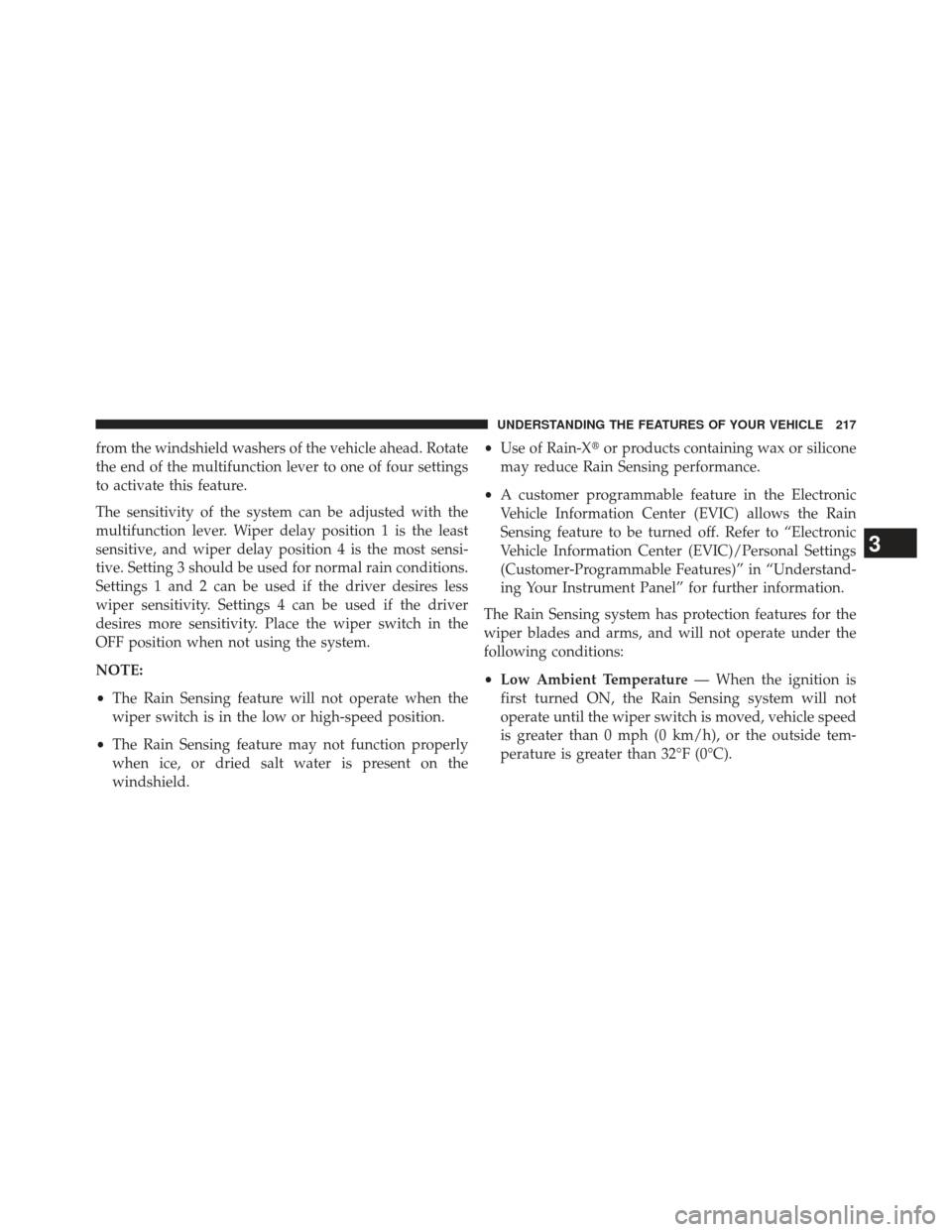
from the windshield washers of the vehicle ahead. Rotate
the end of the multifunction lever to one of four settings
to activate this feature.
The sensitivity of the system can be adjusted with the
multifunction lever. Wiper delay position 1 is the least
sensitive, and wiper delay position 4 is the most sensi-
tive. Setting 3 should be used for normal rain conditions.
Settings 1 and 2 can be used if the driver desires less
wiper sensitivity. Settings 4 can be used if the driver
desires more sensitivity. Place the wiper switch in the
OFF position when not using the system.
NOTE:
•The Rain Sensing feature will not operate when the
wiper switch is in the low or high-speed position.
• The Rain Sensing feature may not function properly
when ice, or dried salt water is present on the
windshield. •
Use of Rain-X� or products containing wax or silicone
may reduce Rain Sensing performance.
• A customer programmable feature in the Electronic
Vehicle Information Center (EVIC) allows the Rain
Sensing feature to be turned off. Refer to “Electronic
Vehicle Information Center (EVIC)/Personal Settings
(Customer-Programmable Features)” in “Understand-
ing Your Instrument Panel” for further information.
The Rain Sensing system has protection features for the
wiper blades and arms, and will not operate under the
following conditions:
• Low Ambient Temperature — When the ignition is
first turned ON, the Rain Sensing system will not
operate until the wiper switch is moved, vehicle speed
is greater than 0 mph (0 km/h), or the outside tem-
perature is greater than 32°F (0°C).
3
UNDERSTANDING THE FEATURES OF YOUR VEHICLE 217
Page 253 of 661
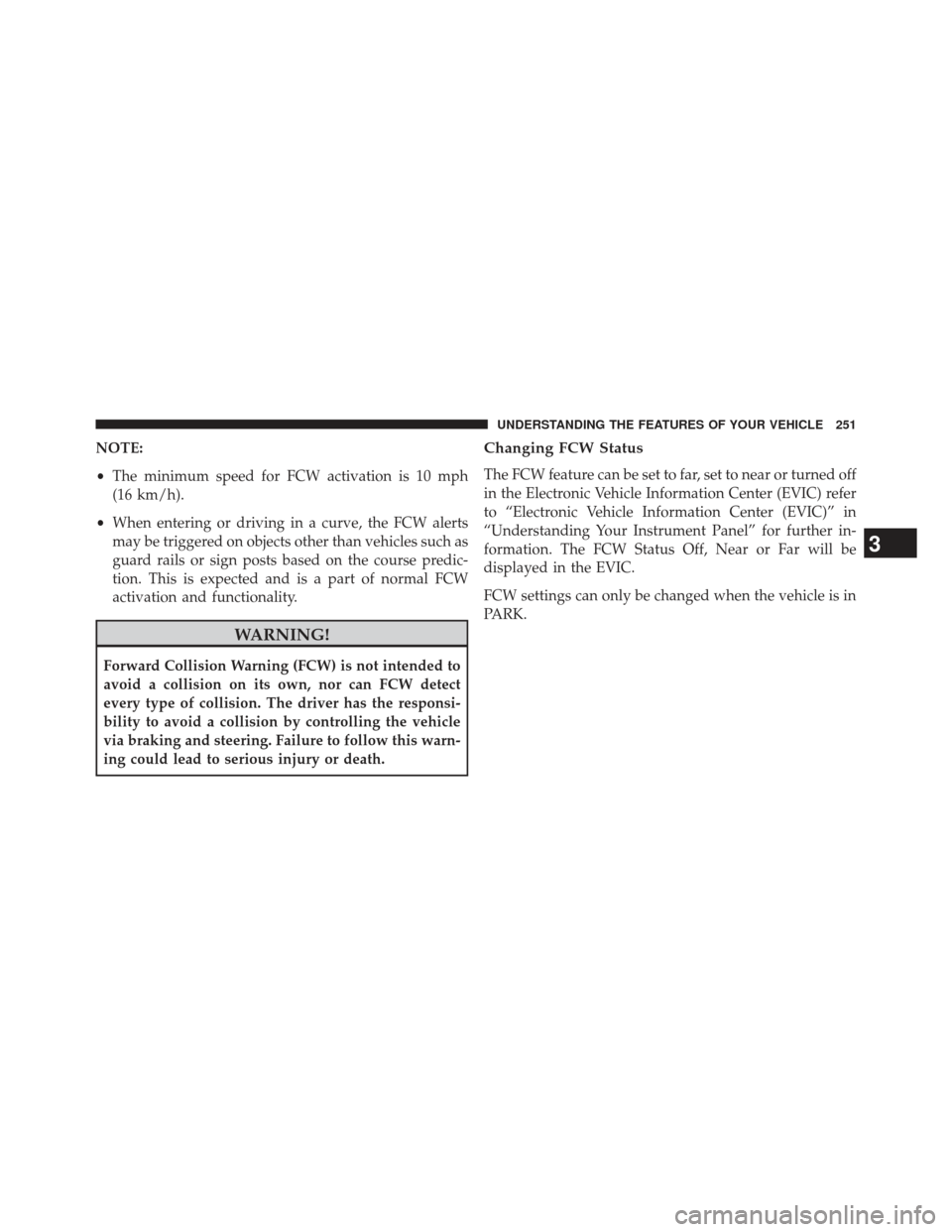
NOTE:
•The minimum speed for FCW activation is 10 mph
(16 km/h).
• When entering or driving in a curve, the FCW alerts
may be triggered on objects other than vehicles such as
guard rails or sign posts based on the course predic-
tion. This is expected and is a part of normal FCW
activation and functionality.
WARNING!
Forward Collision Warning (FCW) is not intended to
avoid a collision on its own, nor can FCW detect
every type of collision. The driver has the responsi-
bility to avoid a collision by controlling the vehicle
via braking and steering. Failure to follow this warn-
ing could lead to serious injury or death.
Changing FCW Status
The FCW feature can be set to far, set to near or turned off
in the Electronic Vehicle Information Center (EVIC) refer
to “Electronic Vehicle Information Center (EVIC)” in
“Understanding Your Instrument Panel” for further in-
formation. The FCW Status Off, Near or Far will be
displayed in the EVIC.
FCW settings can only be changed when the vehicle is in
PARK.
3
UNDERSTANDING THE FEATURES OF YOUR VEHICLE 251
Page 262 of 661
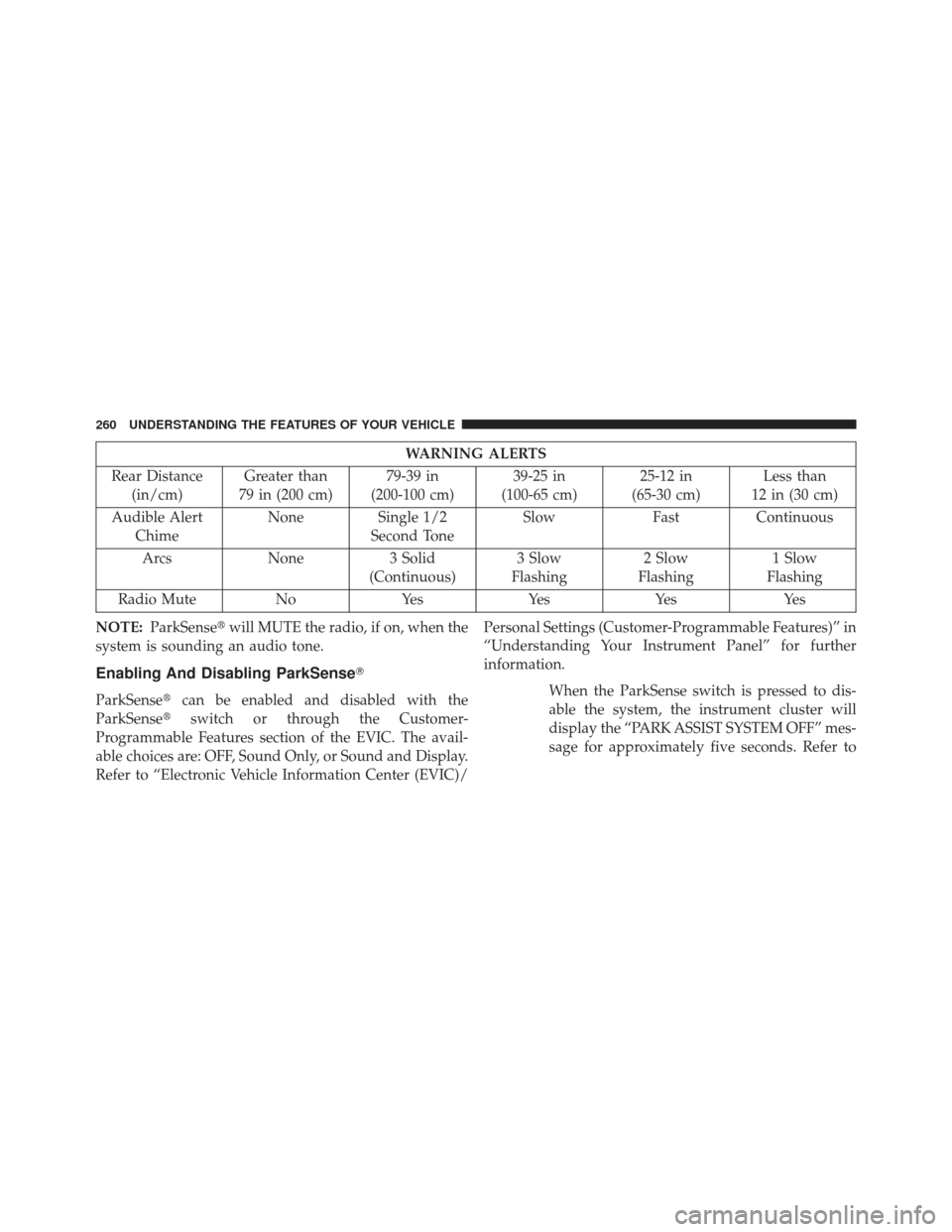
WARNING ALERTS
Rear Distance (in/cm) Greater than
79 in (200 cm) 79-39 in
(200-100 cm) 39-25 in
(100-65 cm) 25-12 in
(65-30 cm) Less than
12 in (30 cm)
Audible Alert Chime None
Single 1/2
Second Tone Slow
FastContinuous
Arcs None3 Solid
(Continuous) 3 Slow
Flashing 2 Slow
Flashing 1 Slow
Flashing
Radio Mute NoYes YesYes Yes
NOTE: ParkSense� will MUTE the radio, if on, when the
system is sounding an audio tone.
Enabling And Disabling ParkSense �
ParkSense�can be enabled and disabled with the
ParkSense� switch or through the Customer-
Programmable Features section of the EVIC. The avail-
able choices are: OFF, Sound Only, or Sound and Display.
Refer to “Electronic Vehicle Information Center (EVIC)/ Personal Settings (Customer-Programmable Features)” in
“Understanding Your Instrument Panel” for further
information.
When the ParkSense switch is pressed to dis-
able the system, the instrument cluster will
display the “PARK ASSIST SYSTEM OFF” mes-
sage for approximately five seconds. Refer to
260 UNDERSTANDING THE FEATURES OF YOUR VEHICLE
Page 263 of 661
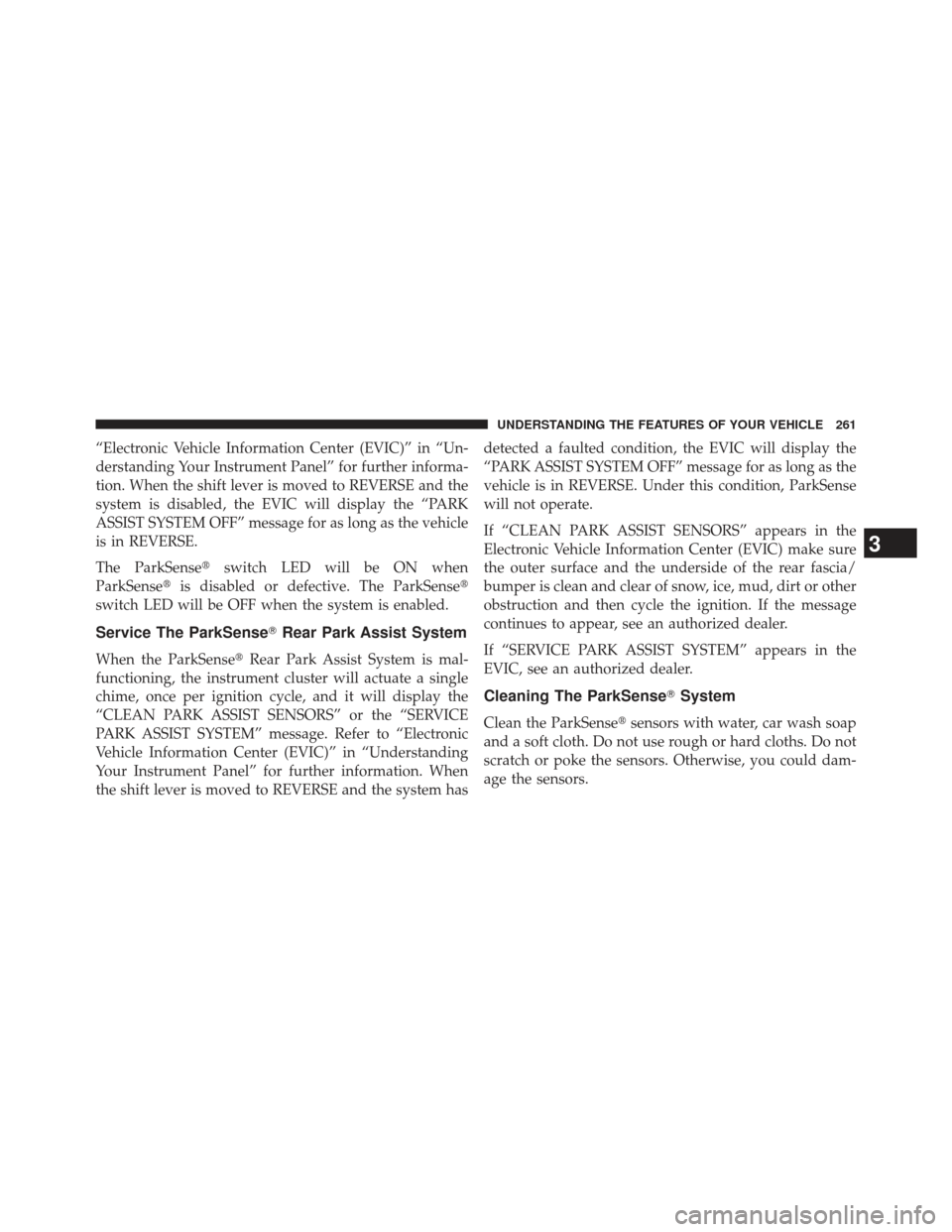
“Electronic Vehicle Information Center (EVIC)” in “Un-
derstanding Your Instrument Panel” for further informa-
tion. When the shift lever is moved to REVERSE and the
system is disabled, the EVIC will display the “PARK
ASSIST SYSTEM OFF” message for as long as the vehicle
is in REVERSE.
The ParkSense�switch LED will be ON when
ParkSense� is disabled or defective. The ParkSense �
switch LED will be OFF when the system is enabled.
Service The ParkSense� Rear Park Assist System
When the ParkSense�Rear Park Assist System is mal-
functioning, the instrument cluster will actuate a single
chime, once per ignition cycle, and it will display the
“CLEAN PARK ASSIST SENSORS” or the “SERVICE
PARK ASSIST SYSTEM” message. Refer to “Electronic
Vehicle Information Center (EVIC)” in “Understanding
Your Instrument Panel” for further information. When
the shift lever is moved to REVERSE and the system has detected a faulted condition, the EVIC will display the
“PARK ASSIST SYSTEM OFF” message for as long as the
vehicle is in REVERSE. Under this condition, ParkSense
will not operate.
If “CLEAN PARK ASSIST SENSORS” appears in the
Electronic Vehicle Information Center (EVIC) make sure
the outer surface and the underside of the rear fascia/
bumper is clean and clear of snow, ice, mud, dirt or other
obstruction and then cycle the ignition. If the message
continues to appear, see an authorized dealer.
If “SERVICE PARK ASSIST SYSTEM” appears in the
EVIC, see an authorized dealer.
Cleaning The ParkSense
�System
Clean the ParkSense� sensors with water, car wash soap
and a soft cloth. Do not use rough or hard cloths. Do not
scratch or poke the sensors. Otherwise, you could dam-
age the sensors.
3
UNDERSTANDING THE FEATURES OF YOUR VEHICLE 261
Page 284 of 661
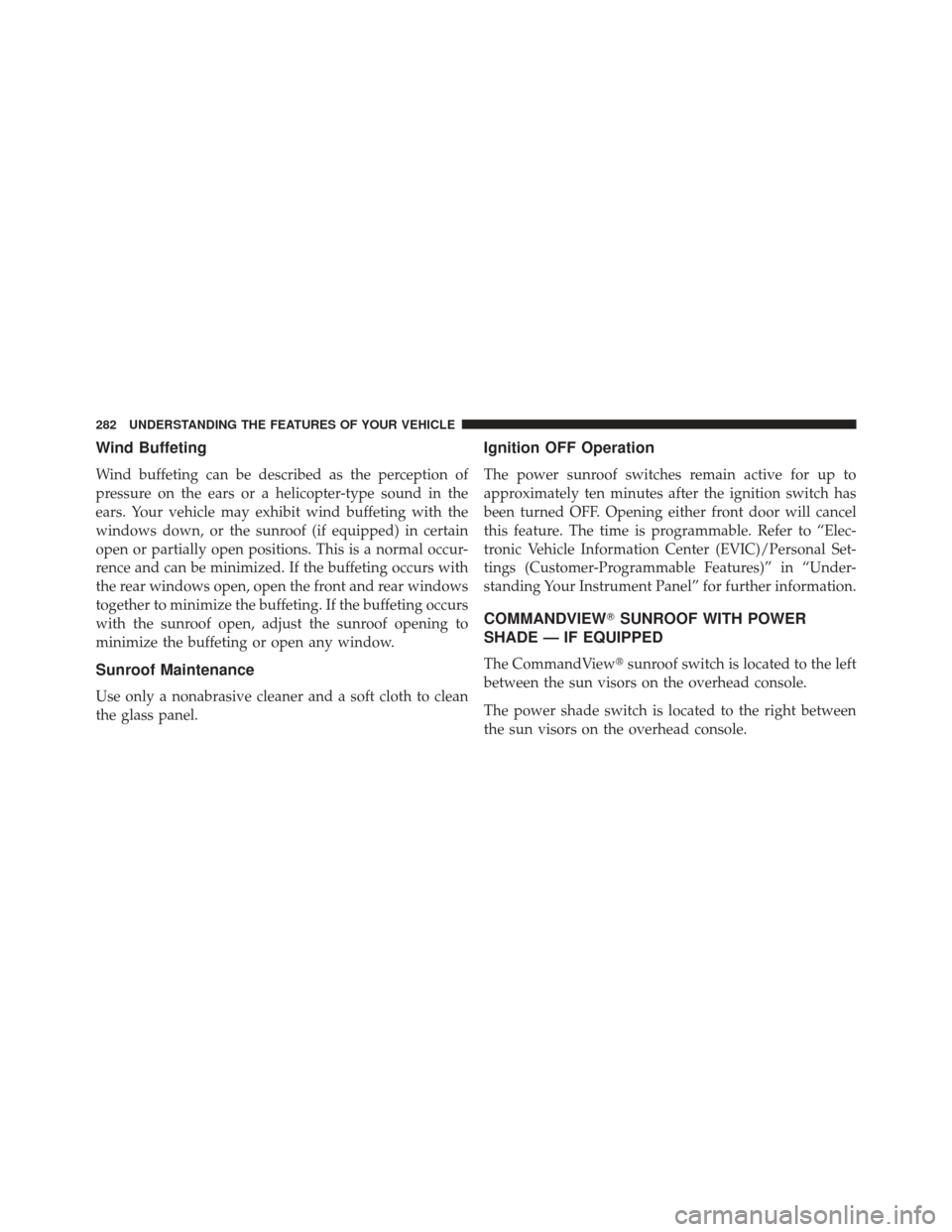
Wind Buffeting
Wind buffeting can be described as the perception of
pressure on the ears or a helicopter-type sound in the
ears. Your vehicle may exhibit wind buffeting with the
windows down, or the sunroof (if equipped) in certain
open or partially open positions. This is a normal occur-
rence and can be minimized. If the buffeting occurs with
the rear windows open, open the front and rear windows
together to minimize the buffeting. If the buffeting occurs
with the sunroof open, adjust the sunroof opening to
minimize the buffeting or open any window.
Sunroof Maintenance
Use only a nonabrasive cleaner and a soft cloth to clean
the glass panel.
Ignition OFF Operation
The power sunroof switches remain active for up to
approximately ten minutes after the ignition switch has
been turned OFF. Opening either front door will cancel
this feature. The time is programmable. Refer to “Elec-
tronic Vehicle Information Center (EVIC)/Personal Set-
tings (Customer-Programmable Features)” in “Under-
standing Your Instrument Panel” for further information.
COMMANDVIEW�SUNROOF WITH POWER
SHADE — IF EQUIPPED
The CommandView� sunroof switch is located to the left
between the sun visors on the overhead console.
The power shade switch is located to the right between
the sun visors on the overhead console.
282 UNDERSTANDING THE FEATURES OF YOUR VEHICLE
Page 288 of 661
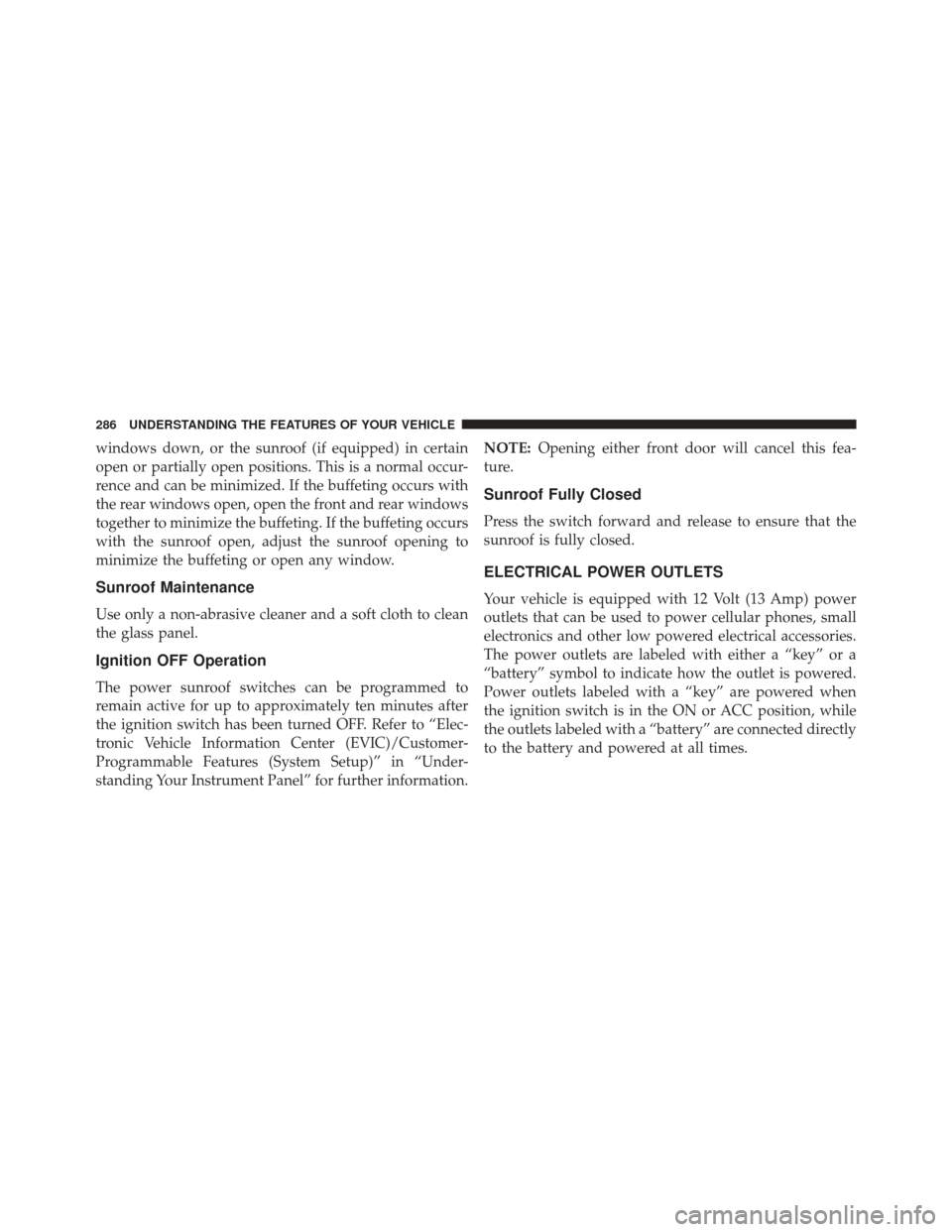
windows down, or the sunroof (if equipped) in certain
open or partially open positions. This is a normal occur-
rence and can be minimized. If the buffeting occurs with
the rear windows open, open the front and rear windows
together to minimize the buffeting. If the buffeting occurs
with the sunroof open, adjust the sunroof opening to
minimize the buffeting or open any window.
Sunroof Maintenance
Use only a non-abrasive cleaner and a soft cloth to clean
the glass panel.
Ignition OFF Operation
The power sunroof switches can be programmed to
remain active for up to approximately ten minutes after
the ignition switch has been turned OFF. Refer to “Elec-
tronic Vehicle Information Center (EVIC)/Customer-
Programmable Features (System Setup)” in “Under-
standing Your Instrument Panel” for further information.NOTE:
Opening either front door will cancel this fea-
ture.
Sunroof Fully Closed
Press the switch forward and release to ensure that the
sunroof is fully closed.
ELECTRICAL POWER OUTLETS
Your vehicle is equipped with 12 Volt (13 Amp) power
outlets that can be used to power cellular phones, small
electronics and other low powered electrical accessories.
The power outlets are labeled with either a “key” or a
“battery” symbol to indicate how the outlet is powered.
Power outlets labeled with a “key” are powered when
the ignition switch is in the ON or ACC position, while
the outlets labeled with a “battery” are connected directly
to the battery and powered at all times.
286 UNDERSTANDING THE FEATURES OF YOUR VEHICLE
Page 289 of 661
NOTE:
•All accessories connected to the “battery” powered
outlets should be removed or turned off when the
vehicle is not in use to protect the battery against
discharge.
• To ensure proper operation a MOPAR� knob and
element must be used.
CAUTION!
Power outlets are designed for accessory plugs only.
Do not insert any other object in the power outlets as
this will damage the outlet and blow the fuse.
Improper use of the power outlet can cause damage
not covered by your New Vehicle Limited Warranty. The front power outlet is located inside the storage area
on the center stack of the instrument panel. Push inward
on the storage lid to open the compartment and gain
access to this power outlet.
Front Power Outlet
3
UNDERSTANDING THE FEATURES OF YOUR VEHICLE 287
Page 291 of 661
Power Outlet Right Rear Quarter Panel FusePower Outlet Fuse Locations
1 — M7 Fuse 20 A Yellow Power Outlet Right Rear Quarter Panel
2 — M6 Fuse 20 A Yellow Cigar Lighter Instrument Panel
3 — M36 Fuse 20 A Yellow Power Outlet Console Bin
3
UNDERSTANDING THE FEATURES OF YOUR VEHICLE 289